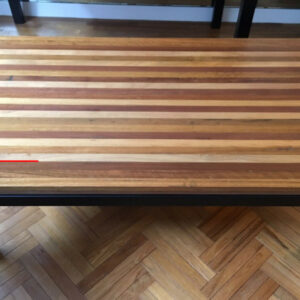I have a 48″ x 72″ table with a surface made of 1.5″ x 1.5″ x 72″ strips of reclaimed wood glued together and mounted to a metal frame with screws. Due to it being stored in a hot garage, it has developed a separation along a seam of about 18″ on one end. See red line in photo.
In order to repair this I assume I would need to remove the top from the frame, squeeze wood glue into the crack, and hold it together with some sort of clamp like a pipe clamp maybe? Any advice or am I taking the right approach?
















Replies
That will work.
Removing the top is not essential.
Consider wedging the crack a LITTLE to allow scraping out of as much old glue as you can.
Another option to get glue in is to use a shop vac on the other side. I did this and it worked very well to get glue in where I could not squeeze it.
What Rob said. Wedge it from the bottom, not the top, so you don't mung up the surface.
Plastic wedges from an auto parts store work well for this kind of repair.
Unwaxed dental floss is good for dragging glue deep into cracks. A plastic straw with a little glue in it can be pinched into the crack and blown through to get glue deeper in also.
Blowing glue in with a straw. That's a new one for me! I like it!
Also take a careful look to see that you are gluing either raw wood or glue. If the split is next to a glue line and exposes raw wood, PVA or whatever your original glue is would be fine. If it split on the glue line and there is old glue present you can go a couple of ways.
One method would be to remove the top, rip down the glue line exposing fresh wood and glue back up normally.
Another is to trust that the residual glue will hold and epoxy the separated section together. PVA is not going to stick to old PVA very well is my point.
Yeah, I'm sure all the dental floss, shop-vac, and drinking straw tricks work great, but I don't trust myself to get those right, especially the prep.
If it were me I'd probably run a thin-kerf blade through the glue line and just re-glue the whole joint if you think the table won't miss the 1/16"...
I just did a test to see about the dry glue thing.
It not only stuck, it stuck quite well!
Old Faithful
I second the idea of running it through the table saw with a thin kerf blade and doing a normal glue up. In the end that will look the least like it has been repaired. Although you will likely have to sand and refinish the entire top.
Any of the above can work. Probably the best to be assured that you end up with a good glue line is to rip and reglue. If you choose to do that, you might consider getting a new 7 1/4" blade. They tend to be somewhat thinner than the full sized blades.
Once you have it repaired, take a look at how the top is fastened to the steel base. Was/is it fastened to allow for expansion/contraction?. I would be concerned that it was not and that is the reason for the crack.
Agree to the method of attachment. that table could move over 1/8 inch or more. The hole for each screw should be twice the diameter of the round head screw with a washer to compensate for the hole
This forum post is now archived. Commenting has been disabled